Ventech China Insight |Exploration and Innovation in Winter Clothing
As the Spring Festival approaches, have you all made your travel plans? Recently, the scene of the “little potato from the south” wearing a colorful down jacket and braving the north to Harbin might have inspired you to take a similar adventure.
In Harbin's sub-zero temperatures, how do the “little potatoes” fend off the cold with their down jackets?
Besides down jackets, are there other products that could be a better choice for us?
Is the "cold-resistant clothing capable of withstanding -196 degrees Celsius" just an advertisement?

Principle of Warmth Retention
The key to the warmth of a down jacket lies in the static air layer formed by the fluffy structure of the down. In physics, there are three ways heat is conducted in air:
Conduction (vibration and collision of air molecules, even in static air, molecules are in random motion);
Convection (gas flow caused by temperature or pressure differences);
Radiation (heat transfer in the form of electromagnetic waves without the need for a medium).
In the case of down jackets, down is composed of thousands of tiny down clusters, and the fluffy, spherical structure can capture air, making it relatively static. Air is a medium with an extremely low thermal conductivity coefficient, approximately 0.027W/m·K under standard atmospheric pressure and room temperature.
In summary, the static air layer formed by down reduces convection, preventing the loss of body heat and thus achieving a "warming" effect.

(Image source: Textile Material Science)
Evolution of Warmth Retention Methods
In ancient times, people mainly relied on animal fur (such as bear, rabbit, and sheep fur), wool, and cotton to make warm clothing. The principle of warmth retention of these materials is similar to modern down jackets, all forming an air layer through a fluffy structure of the material to reduce heat transfer and achieve warmth.
In 1936, American outdoor equipment manufacturer Eddie Bauer designed a new type of warm coat filled with duck down. This coat was initially designed for fishermen working in cold waters but soon gained widespread popularity due to its lightness, warmth, and durability, especially among outdoor enthusiasts. Over time, this design was adopted by other clothing manufacturers and gradually evolved into the down jacket we know today.
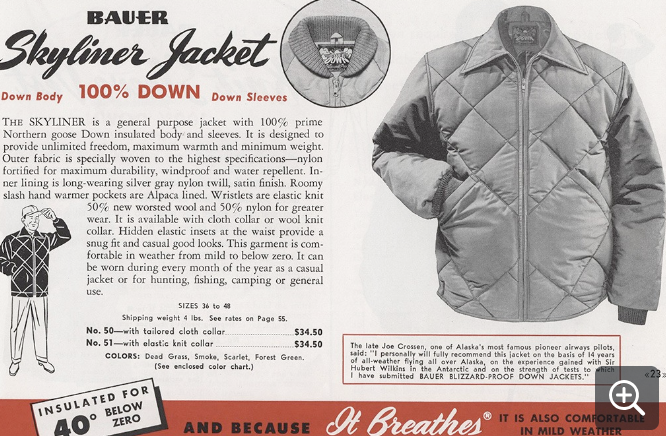
(Image source: The Great Outdoors)
In the early 21st century, people began to try using a more insulating material, aerogel (with a thermal conductivity as low as 0.015 W/m·K), to make warm clothing. Aerogel was first discovered by American scientist Samuel Stephens Kistler in 1931. Initially, due to its unique physical and chemical properties, aerogel was widely used in thermal insulation, absorption, and adsorption fields, etc. For example, in the aerospace field, its excellent thermal insulation properties protected spacecraft from high-temperature ablation when entering the atmosphere and maintained stable internal temperatures in space. However, due to high costs, fragility, and immature technology, aerogel was not applied to the clothing field until 2018 when Supield Technology, the pioneer in aerogel cold clothing, solved the problems of aerogel being prone to powdering and breaking. Supield successfully applying aerogel to the textile field, realizing the large-scale development of aerogel from industrial products to consumer goods.
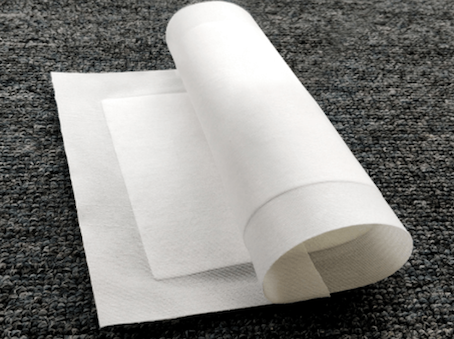
AG-TX Aerogel Fiber: Combining aerogel with polyester fiber, with a thermal conductivity between 0.017 W/(m·K) and 0.020 W/(m·K) (Image source: Shanxi Yangzhong New Material Co., Ltd.)
The reason why the thermal conductivity of aerogel is even lower than air is that it contains numerous nano-sized micropores, which limit the movement of gas molecules within the pores. The frequent collisions between molecules and pore walls consume the kinetic energy of the molecules, reducing their freedom of movement, and thus reducing collisions and heat conduction between molecules. Additionally, due to the small size of the pores, the movement path of gas molecules within the pores is very tortuous, increasing the difficulty of heat transfer between molecules. Therefore, the extremely low thermal conductivity makes aerogel an excellent insulation material.
Although down jackets and aerogel warm clothing have excellent warmth retention properties, they also have some drawbacks. Down jackets are often bulky due to the fluffiness of the filling, while aerogel cold clothing is relatively expensive due to the use of high-tech materials.
In recent years, as a lighter and cheaper alternative, fleece has gradually become a popular choice in the market. Its origin can be traced back to the 1980s. At that time, the main insulation material for mountaineering clothing was wool, but wool had a strong moisture absorption and took a long time to dry after getting wet, which was very troublesome for climbers.
Yvon Chouinard, the founder of the top American outdoor brand Patagonia, began to consider the possibility of using synthetic materials to replace wool. He approached Malden Mills, a textile factory struggling with the failure of artificial fur and desperately selling off its inventory to recover funds, to develop a new material together. With Patagonia's keen insight into consumer needs and Malden Mills' deep accumulation in fabric technology, an innovative material, Polar Fleece, was quickly introduced. This new material, with its excellent warmth retention and lightness, was quickly favored by outdoor clothing brands and gradually replaced wool in mountaineering clothing. Time magazine even selected Polar Fleece as one of the top 100 inventions of the 20th century. However, due to its relatively complex production process, Polar Fleece initially had a high production cost and was mainly used by high-end brands.
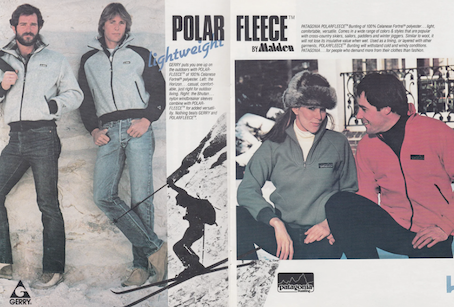
(Image source: The Great Outdoors)
In 1998, Uniqlo introduced the Polar Fleece manufacturing process and made technological improvements. Uniqlo purchased raw materials from local companies and used global cheap labor for large-scale production, achieving the same quality as American products at half the price. This series achieved great success, making Uniqlo the largest clothing retailer in Japan.
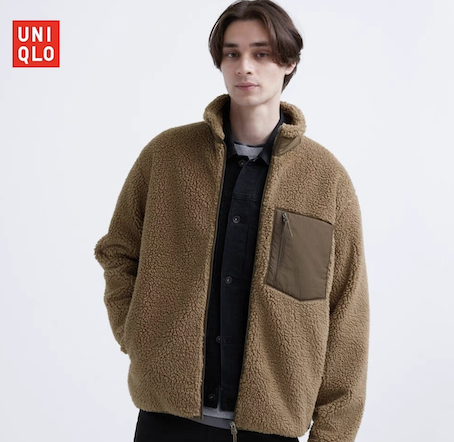
(Image source: Uniqlo official website)
Polar Fleece is made by the process of shaking polyester fibers in a machine, resulting in small ball-like particles on the fabric surface. These ball-shaped fluff particles can lock in air, reducing air convection with the outside world, thus achieving a warming effect. Its cold resistance is twice that of wool (0.08 clo) and four times that of cotton (0.04 clo). The term "fleece" is actually a broader concept, referring to all fabrics with short fluff, with Polar Fleece being one of them. Other common types of fleece include coral fleece, flannel, and imitation suede.
How to Choose a Warm Coat: Is Thicker Always Better?
After understanding the principles of different warm clothing, do you think that a lower thermal conductivity coefficient means the clothing is warmer? Not necessarily. The thermal conductivity coefficient is an inherent physical property of the material itself, which does not consider factors such as the surface area of the clothing, breathability, and tightness, so it cannot directly reflect the actual warmth retention effect of the clothing.
When comparing different brands and types of clothing, the clo value, a comprehensive indicator, is usually used. It refers to the overall heat insulation ability of the clothing, considering factors other than the material's thermal conductivity. The higher the clo value, the better the clothing's warmth retention. (Clo value definition: In an environment with a room temperature of 21°C, relative humidity less than 50%, and wind speed not exceeding 0.1 m/s, the heat resistance value of clothing that makes a person (with a metabolic heat production of 209.2 kilojoules per square meter per hour) feel comfortable while sitting still or engaging in light mental labor is 1 clo.)
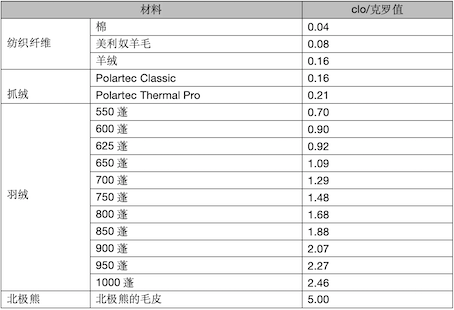
(Image source: Penguin Jun)
Another question to consider is, under the same conditions, is a warmer coat always thicker? For example, is a higher down fill ratio in a down jacket always better? Thicker clothing can capture more static air layers, increasing the length of heat conduction, thus enhancing the warmth of the clothing. However, when the air layer exceeds a certain thickness, the air layer close to the body is warmer than the outer layer, and warm air, which has a lower density, rises, while cold air sinks to fill the position of the rising warm air. When cold air contacts the body and becomes warm, it rises, and when warm air at the outer layer of the clothing contacts the surrounding cold air, heat is transferred to the external environment and decreases. This rising and sinking air circulation forms a convection cycle, taking away heat.
Therefore, thicker clothing does not necessarily mean warmer.
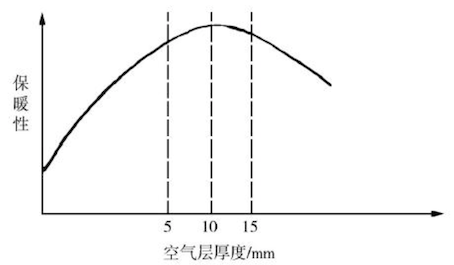
Relationship between Insulation and Air Layer Thickness (Image source: Testing Standards and Evaluation Labels for Clothing Insulation Performance)
Continuous Breakthroughs and Innovations in Cold-Weather Clothing Performance
Although aerogel mentioned above is currently the best material for warmth retention, its fragile nature limits the amount added to fibers, which restrict its potential in cold-weather clothing. A popular aerogel cold-resistant clothing brand once launched "cold-resistant clothing capable of withstanding -196 degrees Celsius." However, many consumers have expressed that it is already difficult to ensure warmth at temperatures near zero, let alone -196 degrees. In addition to being fragile, aerogel particles may fall off during washing, and their microporous structure may be damaged, significantly reducing their warmth retention.
But human’s exploration of new materials for warmth retention has never stopped, with new breakthroughs in performance, practicality, price efficiency, and sustainability.
Polar Bear Sweater
In December 2023, scientists at Zhejiang University improved the properties of aerogel, createt a sweater that is as warm as a down jacket but only one-fifth the thickness. Inspired by the polar bear fur with an extremely high clo value (5 clo), the team discovered that polar bear fur has a hollow structure, encapsulating a large amount of "static" air, and each hair has a waterproof outer layer. Inspired by this discovery, the research team developed a new "core-shell" structured fiber. The porous aerogel is covered by a layer of TPU (thermoplastic polyurethane rubber), which provides excellent mechanical support, making it durable, stretchable, and washable. This synthetic fiber maintains its performance even after being stretched to twice its length 10,000 times, and its structure remains unchanged when submerged in water, dried, or dyed.

(Image source: Coozhi)
However, the current method of manufacturing this fiber is too slow and requires a significant amount of energy, making it unsuitable for mass production. There are many examples of enhancing material performance by coating the surface with chemical substances, such as waterproof down jackets that are coated with fluorocarbon compounds or silane-based compounds to form a waterproof film, greatly reducing the impact of washing on the down's loftiness and warmth.
"Self-Healing" Jacket
A high-quality cold-resistant clothing is not inexpensive, and what if it gets accidentally torn by a sharp object and it's difficult to mend it without leaving a trace? In 2017, an American company Imperial Motion launched a nano self-healing jacket. By simply rubbing the damaged area with hands to generate heat, the tear can automatically heal. The jacket uses Nano Cure Tech, a nano repair material developed by a resrach team at Pennsylvania State University, with a layer of nano repair PET coating on the fiber surface, which has high viscosity, elasticity, and cushioning properties. When an object penetrates the material, the inherent structure of the fiber is not destroyed but pushed to the side. The heat generated by finger friction can promote the recovery of the inherent structure of the fabric, but currently, it can only repair small holes. We look forward to the further development of this technology, extending it to winter clothing such as down jackets.

(Image source: Imperial Motion official website)
Whether it's the lightweight warmth or the fashion trend led by fleece, technology is driving the transformation of the apparel industry at an unprecedented speed. In the future, we believe that technology will continue to iterate, not only enhancing the functionality and comfort of clothing but also bringing more personalized and intelligent wearing experiences to consumers. Ventech China has been continuously tracking cutting-edge technology in the apparel field, and in the future, we will continue to work with outstanding startups to drive technological innovation in this filed, enhancing the quality of life for consumers.
